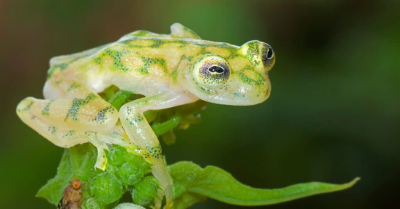
Glass frogs live on trees, are active at night, and many of them are difficult to spot because of their green skin that merges well with their environment. "But these amphibians become true masters of camouflage during the day when they're asleep." How? Come, let's find out.
When glass frogs rest or sleep, their muscles and skin turn transparent. So, whats visible are their eyes, bones, and internal organs. It is hard to spot them because they sleep on the bottoms of huge leaves and also blend well with the environment due to their transparency. But, how do they turn transparent, and what about the visibility of blood? Red blood cells absorb green light (the colour of light usually reflected by plants and other vegetation), and reflect red light. This makes blood highly visible, especially against a bright green leaf. In the case of glass frogs, though, something extraordinary happens.
A research team recently "observed that red blood cells seemed to be disappearing from the circulating blood" when the frogs rest. They conducted additional imaging tests on the animals, proving via optical models that the animals were able to achieve transparency because they were pushing red blood cells out of their vessels. It was suspected that the cells were being stored in one of the frog's inner organs. which are packaged in a reflective membrane.
To find out where exactly the blood was going, scientists used a non-invasive imaging technology called photoacoustic microscopy (PAM). And the result was startling. The primary result is that whenever glass frogs want to be transparent, which is typically when they're at rest and vulnerable to predation. they filter nearly all the red blood cells out of their blood and hide them in a mirror-coated liver – somehow avoiding creating a huge blood clot in the process." When the frogs "are awake, stressed or under anaesthesia their circulatory system is full of red blood cells and they are opaque". This unique capacity would explain why there are hardly any other land-based vertebrates that can achieve such transparency.
Also, in "most animals, pooling blood together leads to clotting which can be life-threatening, for example = leading to heart attacks in humans". So, studying these amphibians can even help us understand blood clotting better.
Picture Credit : Google




